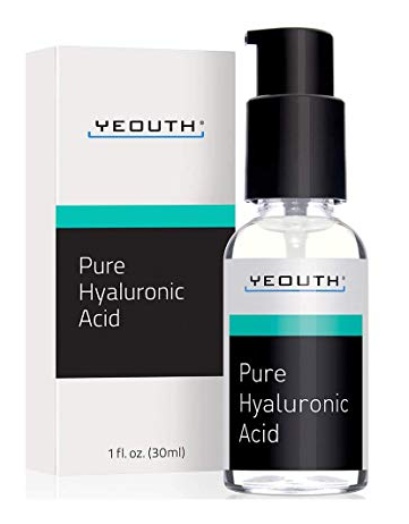
Hyaluronic Acid Serum
This high potency serum is a multitasking product. Loaded with pure Hyaluronic Acid, a powerful humectant that soothes, repairs, and plumps skin while toning and maintaining moisture for long lasting hydration.
Uploaded by: mihaisimion on
Highlights
Alcohol Free
Fragrance and Essential Oil Free
Key Ingredients
Skim through
| Ingredient name | what-it-does | irr., com. | ID-Rating |
|---|---|---|---|
| Hyaluronic Acid | skin-identical ingredient, moisturizer/humectant | goodie | |
| Phenoxyethanol | preservative |
Yeouth Hyaluronic Acid SerumIngredients explained
Hyaluronic Acid - goodie
What-it-does:
skin-identical ingredient, moisturizer/humectant
- It’s naturally in our skin and behaves there like a sponge
- It can bind up to 1000 times its own weight in water
- It is a big molecule from repeated subunits (polymer) so different molecular weight versions exist (unfortunately there is no way to determine MW from INCI list only)
- High-molecular-weight-HA (>500 kDa) is an excellent surface hydrator, skin protectant and can act as an osmotic pump helping water-soluble actives to penetrate deeper into the skin
- Low-molecular-weight-HA (< 500 kDa) can hydrate the skin somewhat deeper though it is still a big molecule and works mainly in the epidermis (outer layer of the skin)
- Low-molecular-weight-HA might also help the skin to repair itself by increasing its self-defense (~ 200kDa used in the study)
- Ultra-low-molecular-weight-HA (<50kDa) is a controversial ingredient and might work as a pro-inflammatory signal molecule
What-it-does:
preservative
It’s pretty much the current IT-preservative. It’s safe and gentle, but even more importantly, it’s not a feared-by-everyone-mostly-without-scientific-reason paraben.
It’s not something new: it was introduced around 1950 and today it can be used up to 1% worldwide. It can be found in nature - in green tea - but the version used in cosmetics is synthetic.
You may also want to take a look at...
| what‑it‑does | skin-identical ingredient | moisturizer/humectant |
A famous natural moisturizing factor that can bind up to 1000 times its own weight in water. Works as an excellent surface hydrator in skincare.
[more]
| what‑it‑does | preservative |
Pretty much the current IT-preservative. It’s safe and gentle, and can be used up to 1% worldwide.
[more]





